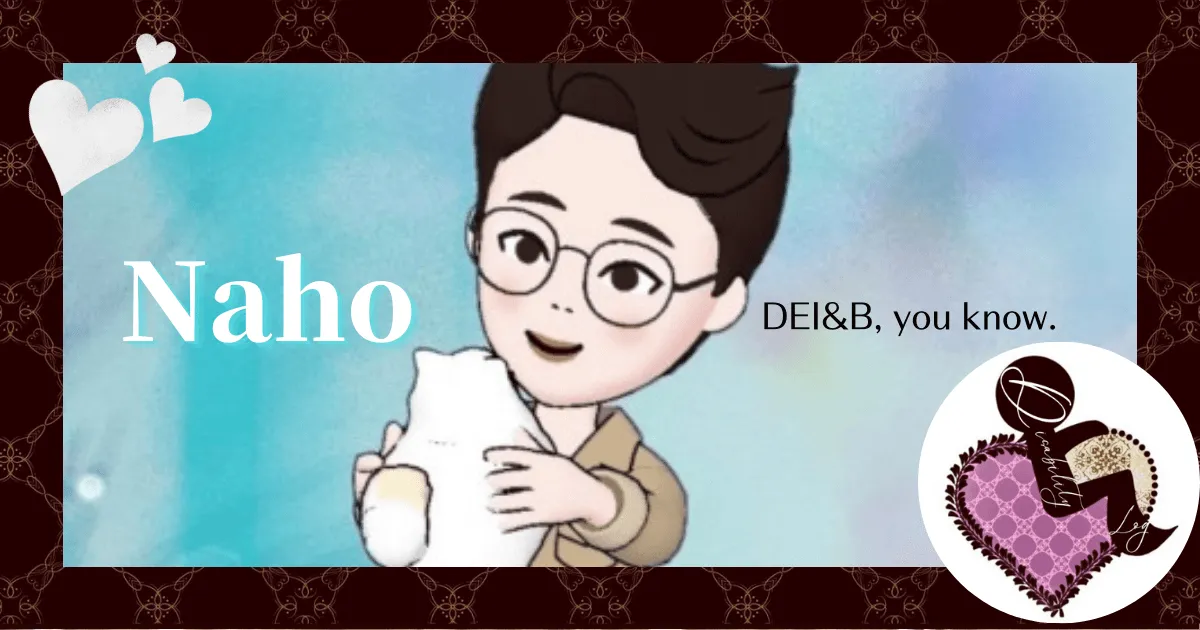
The fifth member to be introduced to DisabilityLog is that much-anticipated one!

Hi everyone, my name is Naho and I was recently invited to join DisabilityLog. Please take a look at 🌈🐕
Prof. Naho’s self-introduction

Pleased to meet you!
First of all, please introduce yourself.

I work as a consultant in Japan, specializing in diversity, especially in the area of DEI&B, in my outreach activities. My colleagues so far include wheelchair users, people with chronic illnesses including vision and hearing, caregivers and childcare providers, and people with foreign citizenship. …… There are people with various situations and characteristics.
As we work together, we naturally began to think about how to create a better working environment and society for as many people as possible. I feel that diversity is not something for which there is an answer, but rather something that we need to think about together and practice a form that is in line with that community.

I’m too happy that you, Naho-sensei, with such a wonderful way of thinking, can relate to what we’re doing here on the blog! And I didn’t realize that she is actively promoting diversity on the front lines. I want her to be close to me. I’ll call you “Naho-sensei” now, since you deserve to be called “sensei” from the very beginning!

Naho-sensei, that’s really encouraging to have you as a fellow blogger. Thank you!

Naho-sensei, you are too good person.

Naho-Sensei, you are wonderful!

Thank you all!
I’m so embarrassed that you call me “Naho-sensei”…
What is DEI&B?

What is DEI&B……?

DEI&B stands for Diversity, Equity, Inclusion, and Belonging. It is made up of acronyms of each of these words.
You have heard of diversity, but DEI&B is still unfamiliar to you.
That’s no wonder, as it is a concept that has been advocated overseas and has only been introduced to Japan in the past two to three years.
There is no correct answer, and it is a concept that is currently growing.
My stance is that “Belonging” is especially important!

DEI&B Still may be difficult ……

OK, it is actually very familiar. Let’s go over them one at a time, carefully, because they are a bit more formal. Why is belonging important? I think you will also understand why belonging is important.
Diversity

“Diversity” is a word that we hear often nowadays.
It is often translated as “diversity”.
If there is only one kind of everything, perspectives will become entrenched.
Society is not made up of just “me,” but people of different ages, genders, nationalities, and tastes.
The Internet has developed remarkably over the past 30 years, and with it, the limitations of time and space are no longer comparable to those of the past.
It is no longer possible to express the situation in terms of existing scales and measures.

Hmmm…. It is true that the commonplace is becoming less commonplace……..

Yes. That is right.
In this context, “everyone being diverse” ≈ flexibility in incorporating diversity would be a fitting concept.
It is important to note that just because diversity is achieved, it does not necessarily mean that there is a state of confusion or that everything is a jumble.
We can think of diversity as constituting the foundation of the mutual awareness that is required for mutual recognition and respect.

So it’s a base, an important idea!

That’s right…it is the foundation of taking care of yourself and others.
Equity

Then, is it good that there are many things, each of which “just exists”?
It is good to be able to exist without being conscious of it.
However, it is important to note that our brains and minds unconsciously categorize and exclude those who are different from us.
This can be even more troublesome if you belong to the majority.
It can lead to behavior that unfairly excludes the minority, creating bullying and pressure.
Perhaps the majority may even become unstable if there is no synchronization.

It is important to acknowledge the existence of those who are different from us.

Yes. In a situation where diverse entities coexist, what is necessary is that all people, regardless of their circumstances, have equal opportunities and rights, and are able to challenge without fear of infringement.
This is “fairness.
Inclusion

In a situation where diverse entities coexist, another important aspect is inclusion.
Are all members who share the same goals informed? Are people restricted from participating or not depending on their position?

Come to think of it, it might be hard to get everyone to participate.

As talked about in the SDGs (Sustainable Development Goals), “leave no one behind” can be thought of as the very phrase referring to Inclusion.
It is easy to state this, but it takes a lot of ingenuity to put it into practice.
Belonging

And let’s remember the “B”. It was “Belongingness.”
Traditional diversity has been moving in new directions, gradually making up for missing ideas such as D&I and DE&I.
And now we have finally reached the point where we are aware of DEI&B.
Fairness is assured, no one is left out, and diversity is achieved. ……
Of course this is all lovely, but am I the only one who feels that diversity without the inclusion of belonging is a dream somewhere far away?

I think it is very important that no one is left behind. I think that each of us should ask ourselves whether we are making unconscious assumptions and prejudices, using “unconscious bias” as a starting point. I don’t think this is a pipe dream. If everyone consciously faces diverse people and practices respect, “true diversity” can be realized.

While some may feel that words such as belonging and affiliation are seemingly the opposite of diversity, it may mean that we need to broaden our perspective a bit.
Here is what happens if we incorporate, for example, community and “belonging,” which underpins a certain personality.
Belonging is simply a word that indicates “belonging,” which means that we construct our own identity while relating to our surroundings through a kind of attribute that indicates who we are. The effect of belonging is to ensure psychological safety, which leads to more confident and personable behavior.

You hear a lot these days about “psychological safety!” Just being part of a team that is easy to talk to gives you a sense of security. DisabilityLog is a group of blog members with such warm and kind hearts, which makes me feel very comfortable.

There is a field of study called attachment theory. According to this theory, the behaviors that humans take in order to develop socially and mentally as they grow up are called attachment behaviors.
Among these behaviors, there is the idea that the target of attachment is recognized as a safe base, and the self, including feelings, thoughts, and expectations, are formed through repeated activities of exploration of the surroundings and returning to the target.

I see! Indeed, the dilution of community is a social problem. Forming connections that allow for attachment and thinking about how to create a sense of belonging are also essential to promoting diversity.

Increased engagement directly leads to better team performance! I think it is most important to foster an organizational culture where people recognize each other and make the most of their talents.

If we assume that everyone has attachments based on the experiences they hold, we can imagine that belonging can be a catalyst for understanding others. Thus, when we are aware of the environment in which we are belonging, a sense of solidarity is created and communication is activated. Even when we are faced with events that we cannot handle alone, we can recover based on respect and esteem for one another, which is fascinating.

I’ve found that “belonging” is a necessary component of a person being who they are!

Yes, that’s why the “&B” in DEI&B is so important.
Let’s keep diversity close to home!

I am glad to know about “DEI&B” thanks to Naho-sensei. I would like to spread it more and more from now on. Let’s get all kinds of people involved and achieve “true diversity” together! As a closing remark! “DEI&B, you know.“

DEI&B, you know.
Summary – DEI&B is a new concept in diversity.

I have summarized the abstract (summary) in English on DEI&B in two PDF files.
Please also see the following files.

The link to LinkedIn (Naho and the DEI&B Research and Practice Group) is included in the QR code at the end of the second page of the PDF. We appreciate your following and signing up!

This is the first announcement in the blog, but DisabilityLog has also started a new venture: a LinkedIn newsletter.
↓LinkedIn URL


This is also irregular, but we hope you will come take a look.
And we look forward to your subscription!
Related articles about DisabilityLog↓

















コメント